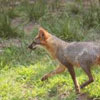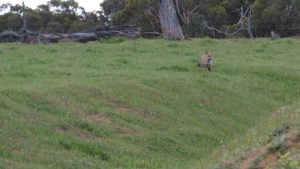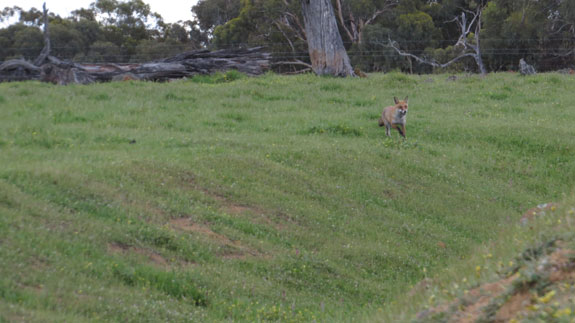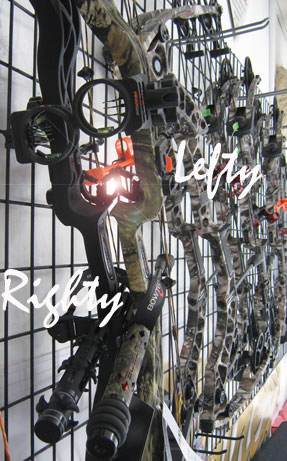
Experienced types know getting a bow is only ëstep oneí of many in this game of mastering their bowhunting and field shooting sport. Building a perfect hunting or field rig takes time. And this equipment upgrade phase is really fun. Really fun. But what do you plan to work on once youíve finished experimenting and your rig is perfect? Of course Iím assuming your shooting technique is clean, debugged and tight. And Iím assuming youíve spent hours lobbing arrows into the 20-ringÖ maybe itís time to have a think about nailing your distance judging skillsÖ
Mastering distance judging is not hard. Itës a technique that must be mastered through practice and one you keep sharp with practice. The trick is to adopt a method. One you can rely on and one that you use every time in your shot sequence.

Rangefinders – the fast and super accurate laser guided tape measure::
I know a bowhunter who reckons every bow should be sold with a rangefinder. I totally get it. Itís a fact, conversion rates will improve with a rangefinder, especially over the longer distances. But did you know snipers sitting their distance judging exam cannot use one? Batteries go flat – thatís why. Theyíre a great tool – use one, absolutely, but donít rely on it. And hey, field archers arenít permitted to use them in competition anywayÖ
Thereís two types of distance judging methodsÖ the Appearance and the Measurable or Unit of Distance Method.

The Appearance Method::
Sometimes itís called the Unmeasurable Method. I use this method because it suits my style of hunting which is focused entirely on predators. The appearance method of judging distance is based on what an object looks like compared to its surroundings. To become proficient in judging distances by this method a great deal of practice is required, under varying conditions of ground and observation. Because I hunt almost every weekend I get that practice and variation. For that reason Iím only mentioning it in passing because, for now, youíll get the best return on effort from mastering the unit of measure method.

The Unit of Measure Method ñ it all starts with the Pace TestÖ
You need to know how many normal paces youíll take when you walk 10m. You need to know this when you want to measure the distance after youíve shot. Do this test over an accurately measured 100m straight line. Walk it with your normal pace ñ no long strides. Walk it with your bow in your hand (wear your daypack and BDUs on if you are a hunter). Count your steps over the 100m and divide by 10 and youíll know how many steps you will take for every 10m you walk. Now you can count steps to your target and know what the distance actually is.
With a well set up field or hunting rig shooting accurately up to 30m is the easy bit. If youíre out a few metres, you wonít be punished so much on score at this distance as you will be at the 40m and 50m range. With the arc of the arrow, itís just maths, also itís just easier to misjudge the longer shots. Itís over the 40m and 50m range these ranging methods give you the best return too.
Always start by taking a read on the distance to your target. Say, on the field course, youíll know whether a group 5 target is set long, short, is at the maximum distance just be looking at it. Itís measurable because you have a target of a known size. Snipers may use a Jerrycan or oil drum to scale how far a person is away. Itís the same technique. Itíll become instinct over time to take into account how open, light, dark, backlit etc your target is and how these conditions affect your first range estimation.
Now pick a spot half way to the target ñ judge that distance – double it. Is it the same as the distance you first guessed? In open country, mentally swing an arc of the distance you judge that lonely tree on your left in line with your target. How far past the ëtreeí is your target now? Add this distance to the distance you judge to the tree to be at – does it match your first ëreadí? Shooting downhill – that goat better not be feeding next to a tree or heís done. How far is that tree horizontally from you? Youíve just got your angle compensated range. Read up on Pythagoras and the 3,4,5 triangle and while youíre at it, read up on the Sub-tension rule too.
So hereís the tactic ñ youíve had your first read on what youíve decided is a ëmeasurableí target. Measurable because you can scale it or scale something thatís next to it. Youíve then compared that read to your second read youíve judged from the ëhalvingí or ëflippingí technique. Still in doubt? The tactic that serves you best now is to aim a little a higher. Maths is on your side. Most shots fall low over the distances youíre unsure of.
The real trick is to practice this method as part of your shooting sequence. Remember, what you do in practice is what youíll do in the field. If youíre going to have habits, you might as well have good ones because youíre effectively rehearsing the steps youíll make at show time. Itís even more critical for the ethical bowhunter – we only get one arrow – a field archer will get 40 or more. Get variety – judging distance in forest, open bush, over valley or hill ranges, or the stubble paddock all have their challenges. If the state titles is at another club – make sure you shoot at that club. Get some of that home course advantage. Their range officer will swap up the course proper before the event, thatís a given, but being familiar to all the distance judging cues peculiar to that course can never change.
Practice with ìPick a Distanceî, say 35m, backstop allowing, judge and shoot from the 35m spot to every target on your clubís field course. Count your steps to each target and compare.





